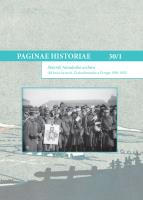Předvolební agitace a volební machinace na Slovensku ve 20. a 30. letech 20. století
Pre-Election Agitations and Election Machinations in Slovakia during the 1920s and 1930s
Author(s): Jan RychlíkSubject(s): History, Political history, Interwar Period (1920 - 1939)
Published by: Národní archiv
Keywords: parliamentary elections; election agitation; political parties
Summary/Abstract: Theoretically, the pre-election campaign was designed as a competition of the political programmes of parties, but as a rule, reality was different. Especially in Slovakia, the election campaign was primarily focused on heaping accusations on the opponents and other political parties as well as on populist promises that every reasonable person must have found unreal. The disruption of pre-election meetings of the competing political parties, often described in the party press, was another peculiar way to lead the pre-election campaign. The character of some disruptions even resulted in heavy injuries and state power interventions. The Hlinka’s Slovak People’s Party with a strong Catholic ideology regularly abused churches and religious pilgrimages for pre-election agitations, although the law strictly banned it. The law was circumvented by organising the party’s pre-election meetings on Sundays right after the service in front of the church or after the formal end of religious pilgrimages. The Agrarian Party (Republican Party of Farmers and Peasants) bought votes in exchange for the promise of land allotments as part of the land reform and deforestation to create new pastures. The Agrarian Party strongly controlled the land reform district offices that were an excellent agitation means, especially in Slovakia. It is certainly no coincidence that land reform was always accelerated before the elections and land was primarily allocated to the Agrarian Party members and adherents.Election machinations were based on the division of electoral districts to ensure that Hungarian voters elected fewer deputies and senators than the same number of Slovak voters. For example, the electoral district XX in Košice that had the largest number of Hungarian voters elected only 7 deputies, while the neighbouring less inhabited district in Prešov that was mostly inhabited by Slovaks elected 10 deputies.
Journal: Paginae Historiae
- Issue Year: 30/2022
- Issue No: 1
- Page Range: 524-543
- Page Count: 20
- Language: Czech

